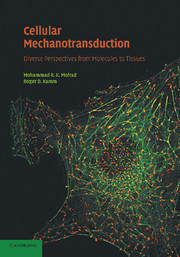Book contents
- Frontmatter
- Contents
- Contributors
- Preface
- 1 Introduction
- 2 Endothelial Mechanotransduction
- 3 Role of the Plasma Membrane in Endothelial Cell Mechanosensation of Shear Stress
- 4 Mechanotransduction by Membrane-Mediated Activation of G-Protein Coupled Receptors and G-Proteins
- 5 Cellular Mechanotransduction: Interactions with the Extracellular Matrix
- 6 Role of Ion Channels in Cellular Mechanotransduction – Lessons from the Vascular Endothelium
- 7 Toward a Modular Analysis of Cell Mechanosensing and Mechanotransduction
- 8 Tensegrity as a Mechanism for Integrating Molecular and Cellular Mechanotransduction Mechanisms
- 9 Nuclear Mechanics and Mechanotransduction
- 10 Microtubule Bending and Breaking in Cellular Mechanotransduction
- 11 A Molecular Perspective on Mechanotransduction in Focal Adhesions
- 12 Protein Conformational Change
- 13 Translating Mechanical Force into Discrete Biochemical Signal Changes
- 14 Mechanotransduction through Local Autocrine Signaling
- 15 The Interaction between Fluid-Wall Shear Stress and Solid Circumferential Strain Affects Endothelial Cell Mechanobiology
- 16 Micro- and Nanoscale Force Techniques for Mechanotransduction
- 17 Mechanical Regulation of Stem Cells
- 18 Mechanotransduction
- 19 Summary and Outlook
- Index
- Plate Section
- References
5 - Cellular Mechanotransduction: Interactions with the Extracellular Matrix
Published online by Cambridge University Press: 05 July 2014
- Frontmatter
- Contents
- Contributors
- Preface
- 1 Introduction
- 2 Endothelial Mechanotransduction
- 3 Role of the Plasma Membrane in Endothelial Cell Mechanosensation of Shear Stress
- 4 Mechanotransduction by Membrane-Mediated Activation of G-Protein Coupled Receptors and G-Proteins
- 5 Cellular Mechanotransduction: Interactions with the Extracellular Matrix
- 6 Role of Ion Channels in Cellular Mechanotransduction – Lessons from the Vascular Endothelium
- 7 Toward a Modular Analysis of Cell Mechanosensing and Mechanotransduction
- 8 Tensegrity as a Mechanism for Integrating Molecular and Cellular Mechanotransduction Mechanisms
- 9 Nuclear Mechanics and Mechanotransduction
- 10 Microtubule Bending and Breaking in Cellular Mechanotransduction
- 11 A Molecular Perspective on Mechanotransduction in Focal Adhesions
- 12 Protein Conformational Change
- 13 Translating Mechanical Force into Discrete Biochemical Signal Changes
- 14 Mechanotransduction through Local Autocrine Signaling
- 15 The Interaction between Fluid-Wall Shear Stress and Solid Circumferential Strain Affects Endothelial Cell Mechanobiology
- 16 Micro- and Nanoscale Force Techniques for Mechanotransduction
- 17 Mechanical Regulation of Stem Cells
- 18 Mechanotransduction
- 19 Summary and Outlook
- Index
- Plate Section
- References
Summary
Introduction
Much like whole organisms, single cells have the ability to “sense” and respond to their surroundings. This “sensing” not only includes monitoring and responding to changes in extracellular chemical messages, but also the physical nature of the cell’s microenvironment, particularly the components of the extracellular matrix (ECM). Anchorage to the surrounding ECM is important for many cellular functions and is mediated primarily by the integrin family, a group of heterodimeric transmembrane proteins that provide physical links of the cell to the external environment. Although integrins were once viewed as structural membrane proteins providing anchor points involved in cell adhesion and movement, they are now known to be centrally important for sensing the external environment and regulating the precise intracellular responses necessary for proper mechanotransduction.
Recent evidence suggests that besides its biochemical composition, the dimensional and rheological properties of the ECM are involved in signaling processes that not only affect cell motility, but also a multitude of intracellular second messenger pathways and gene regulation. In this chapter, we review how cells and their surrounding ECM interact, particularly focusing on integrins and fibronectin, and examine how their points of contact are involved in inside-out and outside-in signaling for setting the stage for mechanotransduction. In addition, a second major focus will be on the most recent findings regarding cellular mechanosensing and its relationship to the ECM. Furthermore, we describe how alterations to matrix components can lead to altered cellular motility, phenotype, and cellular responses.
Information
- Type
- Chapter
- Information
- Cellular MechanotransductionDiverse Perspectives from Molecules to Tissues, pp. 120 - 160Publisher: Cambridge University PressPrint publication year: 2009
References
Accessibility standard: Unknown
Why this information is here
This section outlines the accessibility features of this content - including support for screen readers, full keyboard navigation and high-contrast display options. This may not be relevant for you.Accessibility Information
- 1
- Cited by
